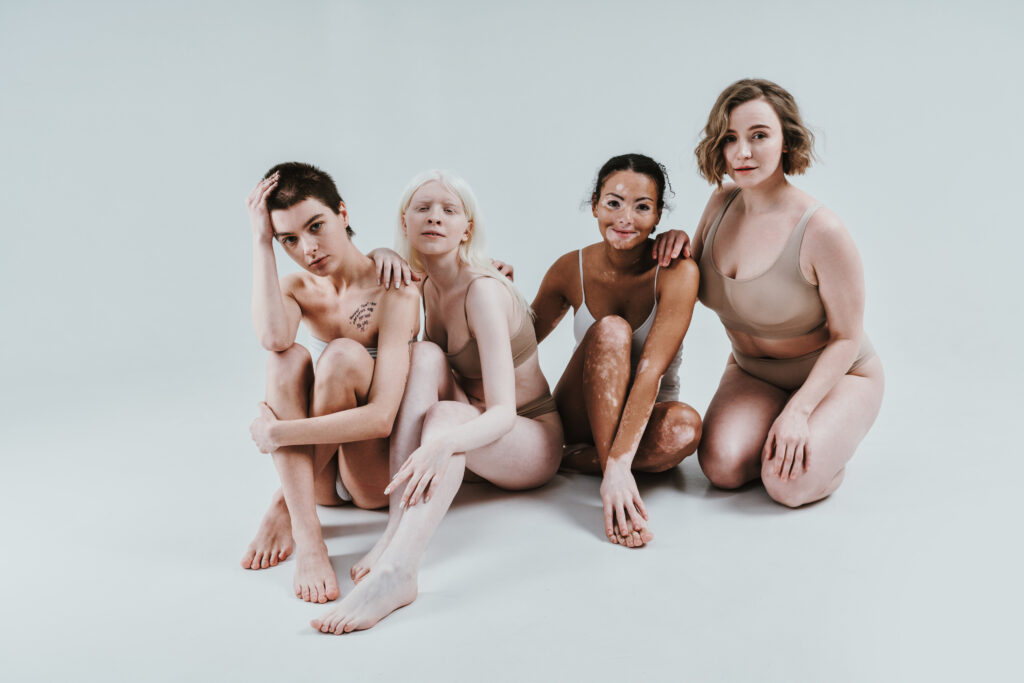We’re Here; We’re Queer, and We’re Insecure: The Queer Body Image Struggle
By Kim Adamski
Body image concerns affect virtually everyone at some point in their lives. Everyone has a body, and it can be hard not to compare our bodies to others’, especially those we see in advertising, movies, and TV. The media regularly sensationalizes dramatic body image issues, from tragic stories of eating disorders to social media’s influence on teens’ perceptions of their bodies.
Sometimes, this coverage leads to positive social changes about how bodies are perceived and commodified, but even with this publicity and social awareness, we still have a long way to go with normalizing body diversity. According to the National Organization for Women, 78 percent of seventeen-year-old American girls feel dissatisfied with their bodies; even at age 60, 28 percent of women still feel this way. Men, who are often overlooked in discussions on body image, also suffer from body dissatisfaction. A study published by the journal Body Image found that 85 percent of men feel dissatisfied with how their bodies look.
Body image issues start young, too. According to Nicole*, age 27, going clothes shopping as a kid made her self-conscious about her body. “All of the pants were low-rise,” she says. “They didn’t fit my body shape, and they weren’t flattering to my body type.” This experience made her feel like her body “wasn’t normal.”
Some research suggests that poor body image may surface as early as preschool. The concerns only increase in adolescence. A YMCA survey of UK 11-16 year olds reported that 35 percent of respondents were “often” or “always” worried about the way their bodies looked.
Negative body image is a pervasive issue for people of all ages and genders. The LGBTQ+ community, however, is disproportionately affected. The Trevor Project reports that 9 in 10 LGBTQ+ youth report body dissatisfaction. Another survey by the Mental Health Foundation found that a third of LGBTQ+ adults reported suicidal thoughts due to their body image, as compared to 11 percent of the straight people surveyed.
Gay men are by far the most reported-on LGBTQ+ group when it comes to body image issues. Body dysmorphia disorder, defined by the Mayo Clinic as a mental health condition where a person can’t stop thinking about a perceived physical flaw, is far more common in gay and bisexual men than in straight men. Ada*, age 27, says that “the term straight thin/gay fat probably is the best way to describe it.” Gay culture, even more so than mainstream culture, pushes an unrealistic and often conflicting standard of beauty. “Either I was too big for some, too thin for others or not muscular enough,” says Ada*. “[For example], someone [turned] me down because my butt wasn’t big enough!” Between social media fitness influencers, comparing oneself to more “fuckable” men on dating apps, and an almost fetishistic view of the ideal male body, the pressure can be intense.
Among trans folks, body image is incredibly complex. Gender dysphoria– the distress caused when one’s gender identity differs from their assigned sex—and body dysmorphia are closely connected. Robin Gatter, MS, CNS, CDN works with trans folks as a nutritionist and regularly encounters body dysphoria in this group. When a person’s body is in opposition to their gender identity, it can cause a great deal of stress. This combined with mainstream ideas of what a body should look like can result in profound dissatisfaction with one’s body, which can lead to negative mental health outcomes and higher rates of eating disorders.
On top of this, Western beauty standards are extremely gendered. Masculine and feminine appearances are heavily socially regulated. We idealize men who are muscular and tall; women, on the other hand, are encouraged to be hairless with large breasts and small waists. These standards are not attainable for most people, especially those whose assigned sex differs from their gender identity. When an individual subverts a socially prescribed aspect of gender, such as being cisgender or straight, they may feel more pressure to “make up” for it by strictly conforming to other gender ideals, sometimes in unhealthy ways like excessive dieting or exercise.
It’s not all doom and gloom, though. For some people, queer identity can have a protective effect on a person’s body image. “Since coming out as nonbinary I feel more comfortable dressing femininely,” writes Reddit user Destriek. I have seen this sentiment echoed on X (formerly Twitter) many times. X user @chamelea22 reports that since realizing they were nonbinary, they feel more comfortable presenting as feminine, too, because they don’t feel as much pressure “to be feminine in a certain, specific way.”
Lesbian and bisexual women in particular tend to have better body image than their gay male and trans counterparts. A 2023 study from the National Institutes of Health found that gay and bisexual women are not as concerned about physical appearance and more likely to have positive feelings about their bodies. Nicole*, 27, states that as a queer woman she has “a better understanding about the range of attraction that people can experience.” She continues, “I feel more confident that I am attractive in my own way, even if [I’m] not universally attractive.”
So, what constitutes a healthy attitude about one’s body? The Australian National Eating Disorders Collaboration defines positive body image as when a person accepts, appreciates, and respects their body. Having a positive body image is associated with higher self-esteem, healthier eating and exercise practices, and better mental health.
Clearly, a positive view of one’s body is associated with better health outcomes. But how do we get there? When a person feels negative about their appearance, it can seem impossible to attain body acceptance. But know this: it can be done!
Seeing a therapist about body image concerns is a great place to start. Therapy helps a lot of people work through negative perceptions of their bodies, and most insurance plans have therapy coverage. There are even therapists who specifically focus on body image! Unfortunately, we have to acknowledge the reality that professional mental healthcare is not accessible to everyone, and that some people don’t trust the mental healthcare system. That doesn’t mean all hope is lost; there are steps you can take yourself.
The Cleveland Clinic suggests focusing first on self-talk. When you think about your body, is it negative? Begin consciously thinking, or even saying aloud, body-positive phrases like “This dress flatters my figure!” or “I look so happy today.” It may feel weird at first, but if you keep at it, it can help a lot.
Next, stop comparing yourself to others! This can be very difficult, because we are socialized to value competition and hierarchies. When you start comparing yourself to another person, try countering it by admiring one of your own qualities, either in your head, aloud, or in a journal. “I tend to focus on parts of myself that are pleasing and that I think look good,” says Ada*, 27, rather than worrying about “the standards of the gay male gaze.”
Ask yourself: What factors are contributing to a negative view of my body? Does scrolling social media make me feel worse? Flipping through dating apps? Reading fitness magazines? Comparing myself to others? Once you figure out your body negativity triggers, it’ll be easier to reduce your exposure to or address your feelings about them.
Engaging in health behaviors can also improve self-esteem and mood. Note that I said “health behaviors.” We are focusing on health, not specifically appearance. A study by the U.S. Department of Agriculture suggests that focusing on personal health rather than physical appearance and weight loss tends to lead to better health outcomes. A healthy–not excessive–amount of exercise, along with eating plenty of nutritious food to fuel your body, can improve your mental image of your body and your physical function. Seek the support of friends and family in your health goals. Even better, enlist a friend to join you in making healthy changes.
Robin Gatter also recommends an approach called “body neutrality.” The body positivity movement, though helpful in many ways, can also lead to feelings of guilt when negative feelings about one’s body arise. “Some days you’re going to wake up in your body feeling bad,” she says. Body neutrality is not about pressure to feel a certain way about your body. It’s about acknowledging your feelings while not treating your body as a problem that needs to be fixed. Given the way most of us were socialized, it’s understandable to have some negative feelings about our bodies, and it’s okay to take baby steps toward body acceptance.
Body acceptance isn’t just an individual endeavor; it means social acceptance of all bodies. We need to work together as a society to change the culture from body shaming to body appreciation. Body acceptance movements have already made significant progress by pressuring companies to use more diverse models in advertising, educating healthcare providers on more inclusive health interventions, and promoting healthier social attitudes about bodies.
We have the power to create change! Modifying how we talk about bodies is an impactful way to shift social attitudes toward body acceptance. Even small changes in your phrasing can make you a role model for others. Avoid using body-critical language. Instead of saying, “I’m going to regret eating this piece of cake!” try “I am so looking forward to this treat.” Rather than “Wow, this guy on Grindr has twig arms!” acknowledge how great it is that there are so many types of bodies in the world to appreciate.
Cultivating a positive self-image of one’s body can be very difficult. There are a lot of factors that get in the way, from unrealistic representations of fitness on social media to fear of romantic rejection. It takes a lot of work and dedication, but be patient and keep at it. You’re getting closer every day.









More Stories
How Can They Keep from Singing?
“My anger problems became a success” – Artist Diane DiMassa on the Collection of her Classic Underground Comic
Young, Queer Love: How Different Is It?